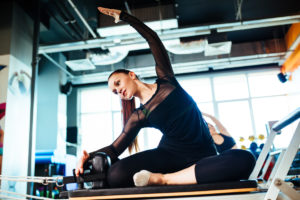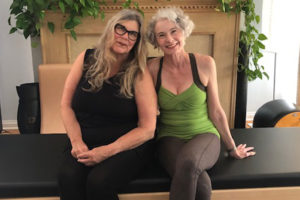Pilates
Pilates Benefits for Older Adults
Mat Pilates benefits for older adults included improved functional mobility, mobility, gait, balance and physical activity.
The Benefits of Pilates for Athletes
Studies have examined the many qualitative benefits of Pilates practice. How do these benefits come into play with Pilates for athletes?
Expand Your Skillset With Pilates and Mind-Body Movement
Pilates and mind-body movement to keep your clients engaged, motivated and eager to keep moving with you in-person and virtually.
Pilates and You
Did you know that modern Pilates is a mind-body exercise approach requiring core stability, strength, flexibility, muscle control, posture and breathing?
Standing the Test of Time
“Returning to Pilates has changed my life,” says Linda Arroz. That’s a powerful affirmation, but Linda’s journey with trainer Jillian Hessel has power to spare. Their story extols the virtues of focusing on health over weight and building connections that stand the test of time.
The Foundation of a Lasting Partnership
It began in 1994. Hessel, a multicertified master Pilates teacher, remembers her first meeting with Linda.
The Science of Pilates Research
When Victor Sanakai was playing tennis for the Auburn University Montgomery National Championship team, he thought he was going to need rotator cuff surgery. But first he sought the advice of Michele Olson, PhD, a Pilates researcher who works with student athletes.
Olson, a senior clinical professor of sport science at Huntingdon College in Montgomery, Alabama, suggested Sanakai try Pilates exercises for the shoulders, upper back and abdominals.
Two of a Kind
When Colleen Evans wanted to improve her strength while healing from Lyme disease, her doctor knew exactly who could help her: fellow patient and personal trainer Shona Curley.
Like Colleen, Curley had been diagnosed with Lyme disease and was coping with its symptoms.
Core Yoga Slow-Flow Sequence
Mindful movement practices like yoga and Pilates allow you to incorporate flexibility, core work and body awareness into your current client programming. Core yoga is a practice that blends the precision, control and core-strengthening benefits of Pilates with the mindful and meditative benefits of yoga.
Try this core yoga slow-flow sequence and share it with your clients!
Pilates Helps Adolescents
6-week Pilates program improved core muscle endurance and hamstring flexibility among adolescents between 9 and 19 years with a history of back pain. Research findings from a preliminary study published in Complementary Therapies in Clinical Practice (2019; doi:10.1016/j.ctcp.2019.01.006) showed that a 6-week Pilates mat exercise program with two 55-minute sessions per week can improve conditioning in both young males and young females.
Pilates and Fall Prevention
As many as one-third of all adults over 65 years old fall each year, with consequences that include serious injury, limited activity and significant costs. Researchers at California State University, Northridge, conducted a study that shows that Pilates reformer training—as little as once per week—can effectively reduce these risks.
Mindful Exercise in the Pool
The sensory-rich pool environment is an ideal setting for mindful exercise and a welcome respite from digital stress.
Pilates for Recreational Athletes
Professional athletes of all kinds have discovered that adding Pilates to their training can improve performance, reduce injury, speed recovery, and help their hardworking bodies stay balanced and healthy (Caple 2016; Knowlton 2016; Saxon 2016). Pilates—a whole-body exercise system that can help you develop strength, functional flexibility, coordination and balance—can offer those same benefits to recreational athletes. A well-rounded program, particularly one offered in a fully equipped Pilates studio, can do wonders for athletes of almost any age, ability or sport.
Cultivate Joy Through Mindfulness
It’s a busy, technology-dominated world—and most of us are continually spinning, twisting and turning in an effort to “get things done” and “produce.” We work, we raise families, we have countless responsibilities. The truth is, this is distracted living, and it raises stress levels, lowers productivity and interferes with our ability to focus. When we live this way, we fail to cultivate a sense of contentment and joy.
The Science of Yoga
“Jane,” like many clients, tried yoga to reduce her stress and anxiety, but she often held her breath during triggering moments, taxing her to the point where she’d feel faint and need to lie on the floor. After taking yoga sessions with Nicole DeAvilla, RYT 500, of Kentfield, California, Jane immediately felt calmer, more grounded and more optimistic.
Women, Men and Mindfulness
Educating men in mindfulness skills via mind-body movement like yoga and tai chi may be more successful than encouraging introspective activities.
In a paper presented in Frontiers in Psychology (2017), Brown University researchers in Providence, Rhode Island, discovered that men and women respond differently to training in meditation and mindfulness skills. Women significantly improved a negative mood by participating in the training, while men felt slightly worse.
5 Ways Pilates Can Benefit Athletic Clients
Recreational athletes have a lot to gain from adding Pilates to their training programs.
Pilates For Postmenopausal Women?
Can Pilates mat exercises help early postmenopausal women to gain strength and flexibility and reduce menopausal symptoms? Korea University researchers wanted to find out, as little research exists on this group.
Are Pilates and Yoga Right for Clients With Low Bone Density?
After working with an older adult (aged 82–92) for 10 years, I was troubled to discover that she had begun having difficulty getting out of the waiting room chair before embarking on our weekly Pilates session. What was I missing? She had faithfully completed Reformer Footwork, Eve’s Lunge and Side Splits, as well as Standing Leg Pumps on the Wunda chair, each week. Why was she continuing to lose leg strength?
Web Extra! Are Pilates and Yoga
Right for Clients With Low Bone Density?
Building Bone: Concepts and Controversies
The positive role that resistance training can play in building and maintaining bone and muscle tissue is well established. But how do other types of exercise affect bone? Recent research findings are sobering.
Walking
Walking does not build bone. Shocked? Doesn’t everyone say, “I don’t understand how I got osteoporosis. I walk. . . .” Most studies show that walking either doesn’t affect bone or may at best prevent bone loss (Martyn-St. James & Carroll 2008).


















